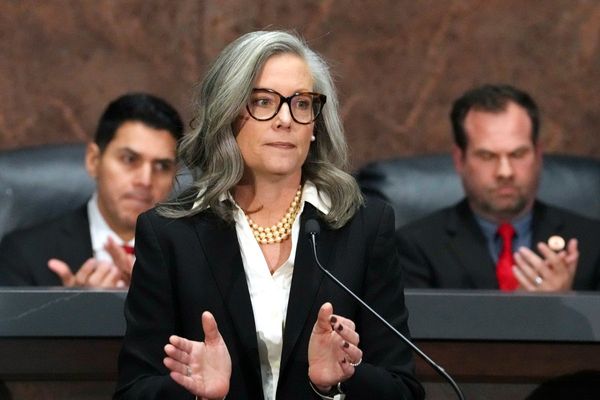
Australia’s $5 note, which has borne the face of Queen Elizabeth II since 1992, will be redesigned to reflect Aboriginal and Torres Strait Islander people’s connection to country and the overturning of terra nullius – a foundational moment in the fight for land rights.
The Reserve Bank of Australia has opened submissions for an artwork to honour the “enduring emotional, spiritual and physical connection” of First Nations people to the land, seas and waters dating back thousands of years.
The proposal to feature Indigenous history instead of the new monarch, King Charles III, on the note drew some criticism when first announced in 2023, with the opposition leader, Peter Dutton, describing it as “another attack on our systems, on our society and on our institutions”.
On Monday, the RBA assistant governor Michelle McPhee said the theme was chosen out of 2,100 nominated themes after an Australia-wide campaign.
The refreshed note will for the first time not feature a portrait of a person. It will still bear the Australian federal parliament on the note’s reverse side.
The RBA said submissions should consider as an important context the overturning of the doctrine of terra nullius, which was the legal justification for treating Australia as a settled colony in 1788, and not a land which had been conquered. It was overturned by the high court through the Mabo decision in 1992, the case which established native title.
“This action recognised the existence of Aboriginal and Torres Strait Islander people’s relationship to Country for thousands of years. The artist is invited to reflect how this decision has shaped a positive future for First Nations peoples,” the RBA said.
The RBA also said it hoped that environmental protection and care was explored through the artwork, to recognise First Nations people caring and prioritising environmental sustainability for tens of thousands of years, and noted that submissions should avoid “tokenistic or stereotypical” elements.
Pro Vice-Chancellor of First Nations engagement at Charles Darwin University, Prof. Tony Dreise welcomed the move.
“Acknowledgement of our people’s deep and uninterrupted attachment to Country should be everywhere,” the Guumilaroi and Euahlayi man said.
“On billboards, in schools, in boardrooms, on TV and on our currency. Tens of thousands of years of connection to Country is worth far more than dollars alone but the nation’s currency provides an omnipresent outlet. to remind all Australians that this is an ancient place.”
Australian bank notes and coins have borne images or engravings of Indigenous peoples, plants and animals since the 19th century, when the country still used pound sterling.
The £1 banknote, first issued in June 1923, was a homage to the artist E Phillips Fox’s Landing of Captain Cook at Botany Bay, which depicted then Lt James Cook and Joseph Banks’ point of first contact – with Gweagal warriors and their spears armed resistance to the encroachment of territory.
In 1966, however, the artwork on the new A$1 note marked the first Aboriginal copyright dispute, after the Reserve Bank failed to seek permission from Arnhem Land artist David Malangi when it reproduced his work on the note. He was later paid $1,000, a medallion and a fishing kit.
The Royal Australian Mint says the $2 coin depicts an “archetype of an Aboriginal tribal elder”, designed by German-Australian Horst Hahne and inspired by an artwork by the UK-born artist Ainslie Roberts, who used some of the features of Gwoya Tjungurrayi, sometimes referred to as “One Pound Jimmy”, as inspiration for the creation of an imagined version of a traditional tribal elder. Tjungurrayi, a Warlpiri and Anmatyerre man, survived one of Australia’s last recorded frontier massacres in 1928 where 60 men, women and children were murdered in the Northern Territory.
In 1995, the RBA released the $5o note, which depicted the author, explorer and inventor David Unaipon, from the Ngarrindgerri nation of present day South Australia.
Entries for the redesign close in April.
• This article was amended on 18 March 2025. A previous version incorrectly stated that the $2 coin depicted the image of Warlpiri and Anmatyerre elder Gwoya Tjungurrayi. The image depicts an archetype of a traditional Aboriginal tribal elder, as imagined by two non-Indigenous artists.







